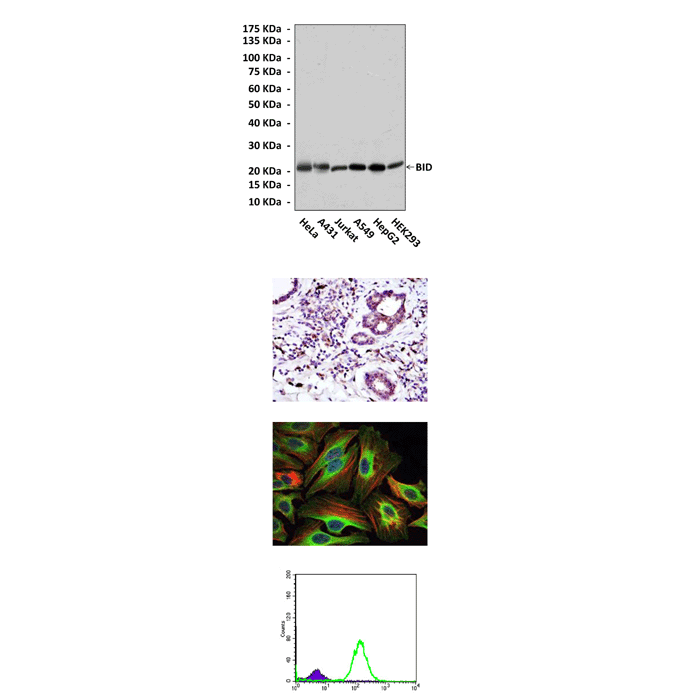Anti-BID: Mouse BID Antibody |
 |
BACKGROUND Bcl-2 family proteins regulate and contribute to programmed cell death or apoptosis. It is a large protein family and all members contain at least one of four BH (bcl-2 homology) domains. The Bcl-2 family of proteins governs mitochondrial membrane permeability and can be either pro-apoptotic or anti-apoptotic. To date, a total of 25 genes have been identified in the Bcl-2 family. Some of the anti-apoptotic proteins include Bcl-2, Bcl-x, Bcl-XL, Bcl-XS, Bcl-w, BAG, and some of the pro-apoptotic proteins include Bcl-10, Bax, Bak, Bid, Bad, Bim, Bik, and Blk. These proteins have special significance since they can determine if the cell commits to apoptosis or aborts the process. It is thought that the main mechanism of action of the Bcl-2 family of proteins is the regulation of cytochrome c release from the mitochondria via alteration of mitochondrial membrane permeability. The pro-apoptotic group of Bcl-2 proteins can be further sub-divided into the structurally diverse 'BH3' only proteins (e.g. Bid, Noxa, Puma and Bad) and the multidomain proteins that share BH1 to 3 (e.g. Bax and Bak). Most Bcl-2 family members contain a C-terminal transmembrane domain that functions to target these proteins to the outer mitochondrial and other intracellular membranes.1
Bid functions as a death agonist that heterodimerizes with either agonist BAX or antagonist Bcl-2. It counters the protective effect of Bcl-2. It is a mediator of mitochondrial damage induced by caspase-8 (CASP8). CASP8 cleaves Bid, and the COOH-terminal part translocates to mitochondria where it triggers cytochrome c release.2 Multiple alternatively spliced transcript variants have been found. The major proteolytic product p15 Bid allows the release of cytochrome c. Isoform 1, isoform 2 and isoform 4 induce ICE-like proteases and apoptosis. Isoform 3 does not induce apoptosis.3
Bid functions as a death agonist that heterodimerizes with either agonist BAX or antagonist Bcl-2. It counters the protective effect of Bcl-2. It is a mediator of mitochondrial damage induced by caspase-8 (CASP8). CASP8 cleaves Bid, and the COOH-terminal part translocates to mitochondria where it triggers cytochrome c release.2 Multiple alternatively spliced transcript variants have been found. The major proteolytic product p15 Bid allows the release of cytochrome c. Isoform 1, isoform 2 and isoform 4 induce ICE-like proteases and apoptosis. Isoform 3 does not induce apoptosis.3
REFERENCES
1. Elmore S.: Toxicol. Pathol. 34:495-516, 2007
2. Willis, S.N. & Adams, J.M.: Curr. Opin. Cell Biol. 17:617-25, 2005
3. Korsmeyer, S.J. et al: Cell death differs. &; 1166-73, 2000
2. Willis, S.N. & Adams, J.M.: Curr. Opin. Cell Biol. 17:617-25, 2005
3. Korsmeyer, S.J. et al: Cell death differs. &; 1166-73, 2000
Products are for research use only. They are not intended for human, animal, or diagnostic applications.
Параметры
Cat.No.: | CP10373 |
Antigen: | Raised against purified recombinant fragments of human BID expressed in E. Coli. |
Isotype: | Mouse IgG1 |
Species & predicted species cross- reactivity ( ): | Human |
Applications & Suggested starting dilutions:* | WB 1:1000 IP n/d IHC 1:50 - 1:200 ICC 1:50 - 1:200 FACS 1:50 - 1:200 |
Predicted Molecular Weight of protein: | 22 kDa |
Specificity/Sensitivity: | Detects BID proteins without cross-reactivity with other family members. |
Storage: | Store at -20°C, 4°C for frequent use. Avoid repeated freeze-thaw cycles. |
*Optimal working dilutions must be determined by end user.
Документы
Информация представлена исключительно в ознакомительных целях и ни при каких условиях не является публичной офертой








